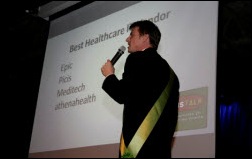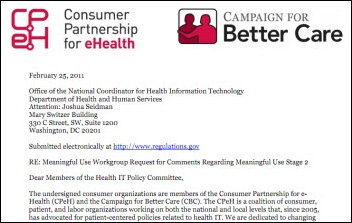Re: Dr Z. Great story, but whatever happened to professional courtesy???
News 3/2/11
From Less Than Grand: “Re: Dr. Gregg’s HIMSS review. I could not agree with you more. The show is lopsided with regards to the audience they are targeting. Though I have attended HIMSS many times in the past, it never fails to disappoint me that the show continues to leave out the physicians who represent the majority of physicians practicing (NOTE: these physicians also represent the majority of those without an EMR.) Great summary!”
From Kubrick’s Rube: “Re: Blue Cat Girls at HIMSS. I thought HIMSS had sunsetted those displays ten years ago, when an exhibitor no one remembers had a small Asian woman in a practically transparent body suit doing mind-blowing contortion. I heard HIMSS got the word out that this kind of entertainment wouldn’t be allowed, but I guess anything to fill the halls …”
From RIFeree: “Re: Vanguard Health Systems. The for-profit laid off 10% of corporate employees on Tuesday.” Unverified, but what appears to be the CEO’s internal e-mail is above (click to enlarge).
From Rockville: “Re: HIStalkapalooza. What a fantastic event! I have never laughed so hard at a trade show in all of my career. Jonathan Bush was one of the funniest, irreverent, and most ‘real’ executives I have met in a long time. I would enjoy working for him. The HISsies and other awards were very entertaining. Thanks for giving healthcare a personality!” His employees in attendance were sure having a swell time, I’ll say that, and that’s a good sign. He looks good in a sash, too (but doesn’t everybody?)
From StatMan: “Re: HIStalk stats. What’s the February number?” I don’t pay too much attention, but it was a record and greatly increased over February 2010. I’m beginning to think it’s like running a publicly traded company – you start to suck once you fixate on the numbers instead of doing whatever it is you’re supposed to be good at. I will have detailed reader survey results up shortly, though, which I do pay attention to. Otherwise, we just do our thing and anyone who wants to read is welcome.
From Art Vandelay: “Re: iPad. Awesome work on the iPad-themed version of HIStalk. You always amaze me with how current you continue to be with trends, news, tech, and I like your music picks too!” Art is observant. I upgraded the mobile format of all three sites (HIStalk, HIStalk Practice, and HIStalk Mobile) this week to provide a rich, functional, fast presentation for iPad, Android, BlackBerry, Palm, and Samsung (it was iPhone and iPod Touch only before). Once I pulled HIStalk up on the iPad I won at HIMSS, I was like, “This looks crappy,” and then realized I could probably figure out how to fix it in my vast amount of spare time. Which I did, and happily so since I know quite a few of you new iPad owners from HIMSS will be checking out HIStalk on your new toy.
From July Johnson: “Re: consumer group’s letter to ONC. I may be overly dramatic, but I believe this is a watershed moment. The battle lines have been drawn between the consumers of all walks of life who won’t accept the system as is any more and expect more for their $30B vs. the providers and IT vendors who want to get billions of $$$ to deliver what they should have delivered without incentives years ago. Reading these positions, it make all the flash and boat showmanship of HIMSS seem extremely hollow when you see what consumer/patients actually want from the system. Now that the mighty consumer/patient has been awakened, providers, vendors, and HIMSS will have no idea what hit them.” The groups include AARP, AFL-CIO, Consumers Union, SEIU, and several others. Their most interesting recommendations:
- Make all Stage 1 Menu items required as Core for Stage 2.
- Improve e-prescribing by encouraging fill-status messages from pharmacy back to the physician.
- Raise the bar for use of evidence-based clinical decision support.
- Require documentation of advance directive.
- Raise the secure messaging bar in Stage 2 to 50% of patients who prefer electronic communication.
- Hold providers accountable for using, not just offering, a patient portal.
- Raise the bar on use of electronic tools for communicating with patients from 20% to 30%.
- Add required experience of care patient and family surveys to Stage 2.
- Require in Stage 2 a care plan that includes a list of team members, problem list, medication list, allergies, advance directive status, and patient preferences for language and communication.
- Don’t let providers meet the HIE requirement in a “test” – make them provide a summary of care record for 30% of their patients who are transitioning to another care setting
- Advance the incorporation of lab results into EHRs.
- Provide a mechanism for patients to flag and correct their health information.
- Encourage accessibility and usability standards so that disabled people can consumer health IT innovations.
- Don’t be tempted to let providers slide on Meaningful Use just because their quality scores are good because quality measures aren’t meaningful to consumers and patients.
Also writing to ONC: eHealth Initiative, which wants increased emphasis on HIEs and better coordination between CMS and ONC on timelines. They make good points about needed clarifications (who’s a license professional when it comes to CPOE? how do you define “structured” lab data?”)
From The PACS Designer: “Re: Apple’s iOS 4.2 release. Apple’s iOS 4.2 has many new features that users will most likely want to use to expand the capabilities for their remote viewing activities. The free iOS 4.2 update brings all-new features to not only your iPhone 4, but also the iPad and iPod Touch.” Above is a video that TPD found.
From Privacy Concerns: “Re: EMR. This represents a creative use.” A PGY1 resident at Christiana Care performs unauthorized physical exams on six women and throws in some no-extra-charge fondling, all undocumented in the chart. Investigators found that he had checked out the electronic medical records of the women before the grope-fest. He’s been fired and warrants are out for his arrest on charges of unlawful sexual contact and patient abuse.
From MarylandSnow: “Re: RealAge. Not news, but since you mentioned it, they sell patient data to pharma along with ads.” I knew that upfront (it’s clear in the sign-up agreement) but I’m actually OK with it. I’m not so gullible that just getting a drug company’s e-mail pitch is going to make me doing anything I don’t want to do.
From Flatlander: “Re: reader’s comment about Lewis & Clark Health Information Exchange (LACIE). Since it wasn’t even mentioned in the article about Kathleen Sebelius, that probably came from the Cerner PR machine. LACIE uses a heavily subsidized HIE platform in exchange for being a national sales reference, and with all participants except one being from Heartland’s normal referral area, it’s hardly impressive and bears no resemblance to a self-sustainable HIE. MU’s Stage 1 HIE requirement is so low (strap a USB drive with one patient’s data on a pigeon’s leg), the one other LACIE participant (St. Luke’s) will be out of there once the incentive check is cashed since its northernmost hospital is a direct competitor of Heartland. St. Luke’s probably got a no-cost deal for the name recognition – they check the HIE box, take the money, and avoid system entanglement and getting their patients recruited.” Unverified.
Also from MarylandSnow: “Re: National eHealth Collaborative. Funding on the line? Although set up with a membership model, their sole funding is ONC – grandfathered in prior to HITECH. Standards and Policy committees with their own multi-million dollar funding have effectively taken over NEHC’s role.” That’s the AHIC Successor that does NHIN stuff.
From Without a Trace: “Re: Usability Symposium Sunday of HIMSS. The whole day was great, but Dr. Friedman from ONCHIT started the day with some big news: usability would be included in Stage 2 of Meaningful Use. The symposium also included speakers from AHRQ, FDA, NIST, Access Board, and big names like Dr. Rob Kolodner and Dr. Dean Sittig. The HIMSS Usability Group announced the release of a new white paper. I expected to read about the ONC’s announcement and news form the symposium in the HIMSS newspaper, but nothing. I can imagine that big vendors wouldn’t be happy about this – I wonder if they were behind squashing the news?” I’ve been darned impressed with the HIMSS Usability Task Force, especially since I bet the HIMSS suits grit their teeth every time they observe that the usability of current clinical software, much of it produced by their cash cow Diamond Members, isn’t very good. I found what appears to be the new white paper, Promoting Usability in Health Organizations: Usability Maturity Model, on the HIMSS site. I haven’t had time to review it yet, so jump in if you’d like to summarize (or I suppose I could try to swing an interview with someone involved in creating it). I still recommend a more dramatic first step: hire an independent firm to evaluate the usability of the top three EMRS in each of the hospital and practice markets and publish the results (you don’t need the permission or involvement of the vendor). Think that wouldn’t put the debate in the public eye?
From HISJunkie: “Re: Texas Health Resources offering HIT consulting services. Epic is doing what IBM did 35 years ago, turning every client into a hosting site (see SHAS circa 1975). Epic is allowing / encouraging the large medical centers to distribute its app on a host basis to almost any remote client (particularly if they are under 150 beds) without incurring a new acquisition or license fee. Just add more work stations and pay a small seat license increment and you can buy them in ‘bulk’. I spoke to several CIOs at HIMSS that are doing this for owned, managed, and non-affiliated facilities. All other vendors require you to pay a sizable new facility license fee. Epic says … not necessary. Oh, but along with the seat charge, they bump up your monthly support fee. How can Epic do this? If you’re a private company, cash is king, not revenue recognition. That’s why you do not see Cerner, McK, Allscripts, etc, do this — Wall Street wants the rev NOW! Epic can wait. Why would Epic forego a possible meaty license fee? They view this as incremental revenue that they would otherwise never see since it’s too costly to sell and support the small or mid-sized facility. (Watch out Healthland, CPSI, HMS, et al.) I predict in the next year you will see many IDNs that are running Epic do the very same as THR. Only trouble is, running a software / service operation is very different than running a facility-focused HIT department. I know, I’ve done both, and the balancing act can make you pull your hair out!” Even Judy critics have to admit she’s brilliant in turning high-paying customers into dealers who can make a little of their money back selling their services to small sites, and in doing so, spread Epic’s reach wider. It’s like creating an Amway sales downline – let someone else do all the sales work on your behalf. I bet the number they watch isn’t revenue or profit, but rather the number of beds or encounters covered – if that number keeps ramping up, the company has endless ways to monetize it down the road. It’s like viral marketing with high switching costs, not to mention that customers aren’t likely to complain publicly about Epic’s solutions when they’re trying to sell them themselves, either internally or externally.
Here’s the Siemens announcement of the hiring of Marc Overhage from Regenstrief and the Indiana HIE as the CMIO of Siemens HSBU under John Glaser.
Capitol Regional Medical Center (FL) will pilot a consumer smart phone app from Healthagen that lets patients who are headed to the hospital fill out information forms and indicate any special needs on their way. Not while driving and clutching their infarcted chests, hopefully.
Bethesda Health Group (MO) is working with Cerner to implement its BeyondNow software in a skilled nursing facility. Cerner acquired BeyondNow in 2003.
Megan provided this pic of her HIStalkapalooza prize-winning shoes since I know the ladies are following that intently. Inga posted a gallery on Facebook.
I ran the news blast earlier that ADP has acquired PM/EMR vendor AdvancedMD. That’s big news because it’s ADP’s first foray into healthcare, other than doing HR administrative work for practices, and they’re a huge company. AdvancedMD had arranged an interview with us beforehand. Below are some snippets from Inga’s notes of her call with Eric Morgan, president and CEO of AdvancedMD. I’m sure she’ll have more later.
I wanted to let you know you were the first ones we thought of. ADP, a company that most of us know, has done a lot of homework in looking at the marketplace and made a decision. They have had a strategy in place to look at adjacent opportunities to grow their business and this is one they have been looking at for well over a year … meaning the smaller to medium-sized physician space AdvancedMD targets and serves.
The matchup between the two companies is very strong. They are certainly focused on our cloud-based, SaaS offering. In fact, they narrowed the field of opportunities down pretty quickly by saying that was the way they wanted to go. They were not going to offer an on-premise approach, so this is very much compatible with what they do with the rest of their business.
The key is they saw value in the business we built here in serving these smaller physician offices. What we do is not easy to do efficiently and effectively. Certainly a lot of vendors in this space have struggled in this. They saw tremendous value in that. This is a big statement for healthcare IT that a company the likes of ADP has made a big commitment and investment in moving into the space from outside the traditional list of folks that you and I are used to talking about.
We will look how we work together and integrate products. All that is part of the plan. We are going to be rolling that out over time. For an ADP client who is interested in practice management or EMR, this makes a very good opportunity for the client to connect very quickly … physicians, much like on the hospital side, more and more will be looking to a trusted leader and a trusted brand. And that scaling of an organization is going to matter more and more … we believe this puts us in a very strong position to be able to give our customers the confidence that they are going with a very, very strong reputable organization like ADP and know that they have a long-term commitment and relationship and investment in the marketplace.
The reaction from the employees has really good. A lot of excitement and buzz here …We are of a size now that they are only a handful or two of folks that are actually bigger than us, yet there are hundreds and hundreds that are smaller than us. I think this puts us in a position to stake a claim among the leaders of the industry.
Inga and I expressed our mutual amazement at how many of our sponsors have been favorably acquired in the last year or two. She wants to get tee shirts made with a list. We can’t decide whether (a) desirable companies disproportionately sponsor HIStalk; (b) we help raise the interest level slightly among potential acquirers; or (c) companies intentionally raise their profile by sponsoring as a signal they are willing to talk, knowing that we have a lot the money people as readers (VCs, private equity, and investment bankers). Regardless, the number is a significant chunk of the total industry acquisitions. Not good for us, of course, since sometimes one sponsor buys another and that means we lose one.
Scottish charge master vendor software vendor Craneware, fresh off an acquisition that gives it a broader US presence, announces record performance for the first half of the year: revenue up 25%, profits up 30%.
Deborah Gage is named president and CEO of MEDecision, replacing founder David St. Clair, who will remain on the board. She was previously CEO of healthcare payment technology vendor GTESS.
From DrLyle: “Re: Post-HIMSS. I agree with you about noticing that the buzz is shifting away from the big vendors and we are seeing the rise of the ‘peripheral companies’ which are creating products that build an ecosystem around the bigger HIT infrastructure. The base level is being set (just like Microsoft and Apple did with operating systems) and it’s time for the next generation of HIT companies to start creating the products that actually move the pointer from ‘up and running’ to actually usable and useful. The good ones will thrive and likely be acquired) while the bad ones will fade away quickly. There are books to be written and movies to be filmed about it all in the years to come.” I like the idea of movies being made about the thrilling world of HIT in the age of MU. Maybe Mr. H and I could cameo (for a large fee). I think I failed to say much about DrLyle as the Ryan Seacrest of the HIT Geeks Got Talent session. He was terrific and the brave souls who pitched their product in something like three minutes were all impressive. DrLyle will have to let us know who won.
ScriptRX raises $1 million of a $2 million offering. The 12-year-old company’s products include ScriptRx Writer, ScriptRX Discharge, and ScriptRx EMR for clinical documentation.
Madison County Memorial Hospital (FL) purchases Healthland’s EHR system. The 25-bed critical access hospital expects to be live and achieving Meaningful Use by July.
Elsevier/MEDai and dbMotion partner to provide dbMotion users with Elsevier/MEDai’s reporting and modeling tools.
HealthShare Montana partners with Covisint to for its statewide HIE.
Just another day at the office: a Georgia pain clinic patient becomes angry about her medication and chases her doctor and his female office manager down a hallway with her cane, threatening to rip the manager’s throat. The patient shoves another doctor trying to intervene before a second doctor is finally able to restrain her.
Gilbert Hospital (AZ) begins its implementation of Prognosis ChartAccess.
Surescripts, AHA, and the College of American Pathologists are awarded a grant by the CDC to connect hospital labs with public health agencies to electronically transmit data on reportable lab results. CDC is calling the initiative the Lab Interoperability Cooperative.
Anyone remember Sarah Kramer, the eHealth Ontario exec who left amidst charges of frivolous spending? ($25,000 to have a speech written; $50,000 to refurnish her office; $192,000 to a single consultant for five months of work.) She left eHealth a couple of years ago, taking her $317,000 severance package with her. She is now executive director of Strength to Strength, a third-party consulting team bringing Epic’s EHR to UCLA Health System.
A reader asked for some pics of the fabulous shoes at HIStalkapalooza. Here is a sampling. Not bad, huh?
New from KLAS: a first-time report on the infrastructure market, with an initial report on wireless communication systems. Execs at provider organizations are adopting VoIP cautiously and physicians are embracing new ways to use their mobile VoIP phones. Vendors included in the study are Ascom, Avaya, Cisco, Polycom and Vocera.
KLAS introduces two offerings that I wouldn’t mind having. KLAS Alert will give providers or vendors a monthly snapshot of satisfaction rating of one vendor or multiple vendors, depending on the subscription level. KLAS Connect will facilitate the connection between providers using similar technologies, giving them the chance to network or compare best practices (or perhaps collectively complain).
Sponsor Updates by DigitalBeanCounter
- Greenville Hospital System (SC) selects Oacis Health Data Warehouse from TELUS Health Solutions to provide analytics and reporting.
- Joe Mason joins Enterprise Software Deployment as VP of Strategic Alliances.
- Riverside Community Hospital (CA) chooses ProVationMD software for its gastroenterology procedure documentation and coding.
- Healthcare innovative Solutions introduces Pillars, a web-based CPOE workflow planner tool.
- Imprivata announces its integration with Epic’s authentication API.
- Lake Regional Medical Group (MO) will implement eClinicalWorks using implementation services from GroupOne Health Source.
- St. Joseph Health System (CA) joins with AT&T to implement a new telehealth project that will allow patients to consult with physicians remotely using AT&T Telepresence Solution.
- M*Modal partners with Greenway to integrate speech recognition into PrimeSUITE2011.
- DIVURGENT releases results of hospital industry’s first survey on business intelligence maturity.
- Novell partners with CynergisTek to create the industry’s first unified compliance and security monitoring solution for healthcare.
- St. Joseph’s Health System (CA) selects Allscripts’ Care Management and Homecare solutions to streamline patient movement through its 14 hospitals.
- Health Language launches LEAP I-10, a cloud-based ICD-10 conversion solution.
- University Health Systems of Eastern Carolina reduces labor costs using Concerro’s ShiftSelect.
- Madison Memorial Hospital (ID) chooses PatientKeeper’s CPOE to achieve ARRA-HITECH compliance.
- CapSite releases new research reports on PACS and teleradiology, with 21% and 31%, respectively, of providers looking to switch their current systems.
- Billian’s HealthDATA profiles Florida Hospital CIO Andy Crowder.
EPtalk by Dr. Jayne
There was an “Ask Dr. Jayne” question awhile back about those pesky doctors who insist on wearing their stethoscopes and white coats even though they rarely see patients. As I was camped out in the Orlando airport trying to catch a much-delayed flight to my frozen home, I witnessed not one, but TWO episodes of Health Professionals Gone Wild.
The first was an actual medical situation, where an inebriated would-be passenger took a spill and whacked her head on a large planter, splitting her forehead like a melon. An angel in pink scrubs jumped to her aid, applying Starbucks napkins to the wound until the gate agent arrived with first aid supplies, followed by the paramedics and lots of security folks who documented the event on film (alas, I didn’t, though, because that would be tacky). After the cleaning crew completed their multi-step decontamination process (which I was able to explain to several of the curious travelers around me who wanted to know exactly why it took so many people and so much stuff to clean it up).
I was waiting for something else to keep me from a post-HIMSS stupor when what to my wondering eyes did appear but three passengers coming off a flight wearing matching green scrubs, one of whom was actually wearing the white coat. Now this I had to photograph. I looked carefully and didn’t see any transplant coolers and they were loitering quite a bit before heading to baggage claim, so I don’t think they were in the organ procurement business.
I never did figure it out. Maybe I should have one of those “submit a caption for this photo” contests. If you look closely, you can see one of the planters in the foreground. Sorry the second one is fuzzy — I was laughing too hard to take a decent picture.
After finally clearing the snow from my car (those of us who work in non-profit land park uncovered) I drove home through precipitation that was exactly the consistency of a frozen margarita. Hard to believe that a few hours earlier I was soaking up rays (with sunscreen, of course) in Orlando. As I went through the mail that had accumulated during the trip, I chuckled at the number of vendor and HIMSS-related mailings that were delivered on or after Monday the 21st. Nuance, SuccessEHS, and CapsaSolutions: you should ask for your marketing dollars back.
Now it’s back to the CMIO grind, with PQRS (aka PQRI) registry reporting at the top of my list. Having done claims-based reporting previously, many organizations are trying our hands at registry reporting this time around. It’s always interesting to wade through the data as it’s pulled out of the system, arguing with the doctors who insist they really did do everything for every metric on every patient even though the data says otherwise. It’s always the data that’s faulty, rather than the physician or the office processes, right?
Although some providers loathe clinical data reviews because it points out what they aren’t doing, I take the opportunity to remind them of the studies that have been done showing the sheer number of hours it would take a physician to deliver all the services that each patient could receive, based on the varying recommendations, guidelines, and mandates.
Frankly, without automated systems, I’m not sure how we kept it all straight. I used to have to wade through multiple flow sheets for multiple diseases rather than having a single cohesive presentation of the patient’s health status that could be graphed, manipulated, extracted, and e-mailed to the patient via a secure portal.
I’m hoping that my physicians who are “passive” participants of registry reporting enjoy the CMS payments they receive based on our data submission. Many of them have never participated in PQR-anything before, due to the annoying nature of claims-based reporting. Some of them have no idea that the hospital is reporting on their behalf.
I think once we go electronic, we tend to forget how painful it could be to document on paper and how arduous it was to extract data. (Not all of us, of course. I still have a couple folks begging to go back to the Golden Age of paper.)
And once the PQRI checkbox is complete, it’s onward to Meaningful Use. I’ll have to dust off my riot gear (and my favorite martini glass) because it looks to be an interesting year.


















Re: July Johnson’s comment: “Re: consumer group’s letter to ONC. I may be overly dramatic, but I believe this is a watershed moment.”
I had the exact same thought. And more. As someone who has experienced consumer/patient/clinician/vendor/consultant roles, I am glad to see the Voice of the Patient Consumer being heard. I have no doubt that ONC will listen more closely to consumers than vendors. And since they’re spending my tax dollars, I hope they do! And those vendors who develop their product with provider usability in mind and ready to deliver for Stages 2 and 3 will go the distance. Unfortunately, some won’t make it….survival of the fittest.
RE: Flatlander
Looks like exchange was a topic. http://www.newspressnow.com/localnews/27005536/detail.html We need more innovation and less PR snide remarks about who has done what. Glad the Secretary got to see what they are doing. Best of luck to everyone working on this, it ain’t easy.
Re: THR…since THR is now a ‘vendor’ does that mean Ed Marx is now ‘plugged’???
It’ll be interseting to hear Ed’s thoughts about going into the ‘dark side’.
“Epic is allowing / encouraging the large medical centers to distribute its app on a host basis to almost any remote client (particularly if they are under 150 beds) without incurring a new acquisition or license fee. Just add more work stations and pay a small seat license increment and you can buy them in ‘bulk’…Oh, but along with the seat charge, they bump up your monthly support fee.”
Aren’t these statements contradictory? The only difference is that Epic hits you with per-seat and service fees instead of facility fees. It’s the same but different. Nothing particularly unique about it. What’s sort of funny to me is that Judy Faulkner has CIOs convinced they’re being savvy, when they’re just being dumb. Maybe they think they’re “expanding the hospital’s outreach” or something along those lines. Sounds like Southwest Airlines, where your bags fly free but your butt pays more to sit in the seat.
Not sure why this is lumped in with the article about THR either. Unless HISJunkie knows something beyond the article, it’s not about Epic at all. It’s about providing consulting services. THR isn’t competing with vendors nor is it spreading the gospel of Epic. They’re just trying to be entrepreneurial and take advantage of the fact that they have a large organization (which probably doesn’t justify its size and cost, I’m guessing?) with more advanced IT knowledge than their peers and want to capitalize by providing consulting services. They’re competing with the HIT consultants out there, like Accenture, in trying to offer services with the added marketing hook along the lines of “we’re health providers, we’ve done it, and we’ll show you how we did it.” This isn’t a particularly new idea – I’ve seen a couple of medical groups try (and fail) to do that same thing locally. Maybe it’ll work out better for Ed and THR, but again, not sure how the 2 stories really relate.
RE: “This represents a creative use of EMR”
Using an EMR to troll for patients for inappropriate purposes is very bad, and can only be circumvented by tight monitoring for unauthorized chart access. The patients were private patients, not on the teaching service. The “footprint” left by this ex-Resident, now fugitive, were likely substantial as he looked around for women to grope.
As I was the original architect of the EMR there in the late 1990’s, and a strong and outspoken (no surprise there, eh?) proponent of rigorous safeguards, I feel quite dismayed about this incident.
The Newark Post (DE) wrote about the incidents here.
— SS
Re: HIMSS
Perhaps HIMSS needs to go virtual, like an Amazon.com, with video demos and ability to try out software being run virtually on HIMSS-azon severs.
Re: new white paper, Promoting Usability in Health Organizations: Usability Maturity Model, on the HIMSS site. I haven’t had time to review it yet, so jump in if you’d like to summarize
I knew I was in for a heaping helping of gobbledegook after reading the title itself:
“Promoting Usability in Health Organizations:
Initial Steps and Progress Toward a Healthcare Usability Maturity Model”
A “Healthcare Usability Maturity Model” is a clue that what follows will take simplicity, and expend considerable ink to tangle it into a mess of process mysticism, buzzwords, paradigms, charts, and other Master-of-the-Obvious-made-to-look-sophisticated, destined-for-the-dusty-shelf consultant report.
That is largely what follows.
I have two other observations:
1. Why is it that health IT usability has to be written about as if from the grade school level, in 2011, some sixty years into the “computer revolution?” Do we still write treatises on why it’s wide to use sterile technique and good lighting in operating rooms?
2. Why is this treatise not entitled “Promoting Usability in Health IT vendor Development Shops: A Vendor Responsibility Model”?
Response to Confused…re THR/Epic
The THR press release specifically says ‘Hosting’ so in my book that means the Hostee uses the Hostors system and does not need to buy/use a system from a commercial vendor. Also since THR is a big Epic user one can easily assume the software they will host is Epic. Maybe even non-Epic apps.
As I pointed out several CIOs told me they are pursuing this strategy at HIMSS (probably to help pay for that big Epic invoice they are looking at monthly).
As far as the payments go they are not the same (other than to say you will be paying something). The host facility usually bills for install time and a transact fee, just like a SaaS, no big capital investment. So Epic gets to deploy its products via SaaS without ever incurring the SaaS facility start up capital costs and ongoing support. Neat trick.
Any incumbent vendor that does not see this an ‘end run’ to steal your current clients…well call me quick, I have some land in Florida I’d like to sell ya.
I would appreciate not having the guy in Papal outfit on the website, I am a devout Catholic and actually find it offensive. We Catholics see the Pope as the direct successor of Peter, so please show some respect.
Thanks